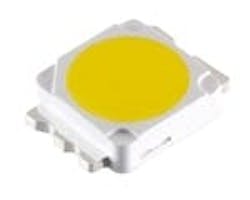Toshiba publishes specs for new GaN-on-Si LEDs
Back in mid-December, Toshiba announced that it was entering mass production of LEDs using a 200-mm (8-in) silicon substrate or so called gallium-nitride-on-silicon (GaN-on-Si) technology. The company has now published data sheets for the initially available products revealing a 3000K LED, a 4000K LED, and two 5000K LEDs.
At the time of the announcement, Toshiba didn't specify efficacy, forward voltage, CRI, or other characteristics of the LEDs, although we speculated on the particulars and were fairly accurate. The cool-white TL1F1-NW0,L 5000K LED with a CRI of 70 offers the best efficacy of the new products.
Toshiba characterized the LEDs at 350-mA drive current. Based on the typical forward voltage of 2.9V, the TL1F1-NW0,L delivers 110 lm/W. The 5000K TL1F1-NW1,L drops to 94 lm/W with a rise in CRI to 80. Both the 4000K TL1F1-WH1,L and 3000K TL1F1-LW1,L deliver 84 lm/W. And both offer a CRI of 80.
Those efficacy values will certainly vary. SSL designers will likely consider the worst-case forward voltage of 3.6V when developing products. That consideration would make the top efficacy of the cool-white LED drop to the 90 lm/W range. The minimum forward voltage is 2.8V.
The data sheets also reveal maximum ratings for the new LEDs. The devices can take as much as 800-mA of continuous drive current or 1A when pulsed. Power dissipation maxes out at 2.9W. Operating the devices at maximum power almost doubles the luminous flux output.
